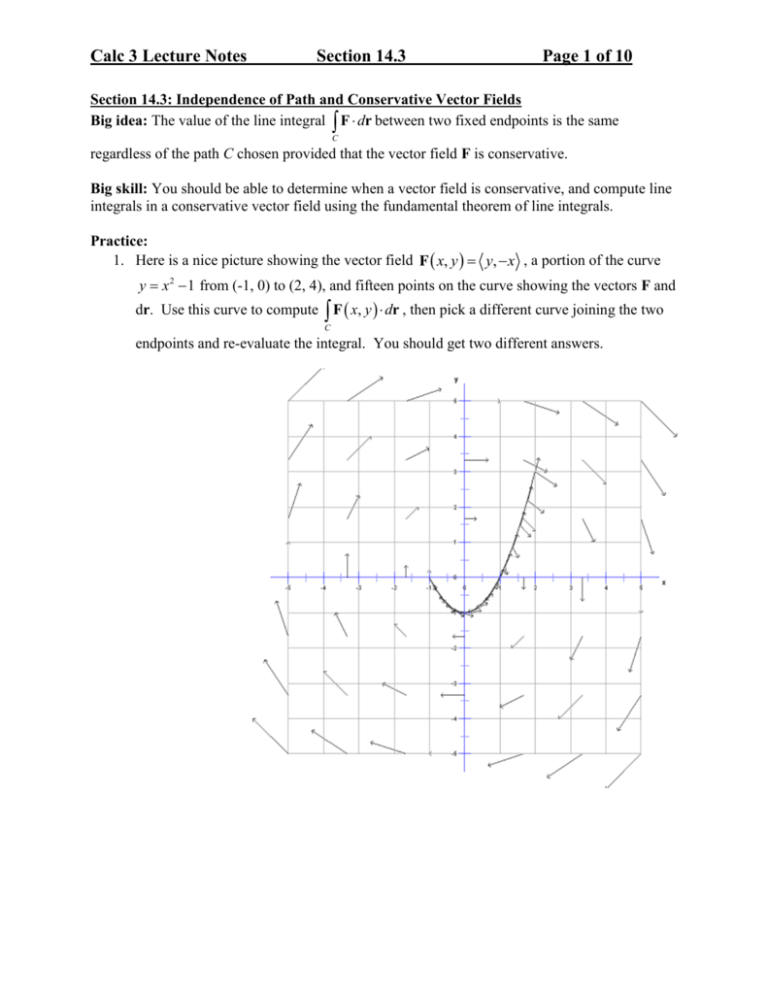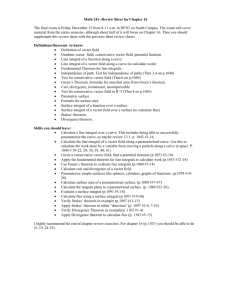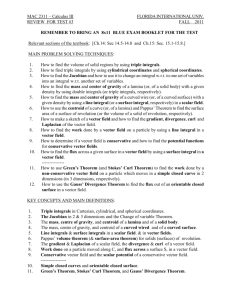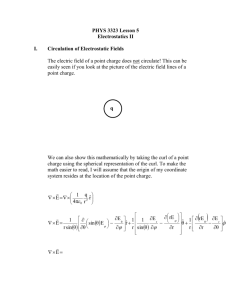Independence of Path and Conservative Vector Fields
advertisement

Calc 3 Lecture Notes Section 14.3 Page 1 of 10 Section 14.3: Independence of Path and Conservative Vector Fields Big idea: The value of the line integral F dr between two fixed endpoints is the same C regardless of the path C chosen provided that the vector field F is conservative. Big skill: You should be able to determine when a vector field is conservative, and compute line integrals in a conservative vector field using the fundamental theorem of line integrals. Practice: 1. Here is a nice picture showing the vector field F x, y y, x , a portion of the curve y x 2 1 from (-1, 0) to (2, 4), and fifteen points on the curve showing the vectors F and dr. Use this curve to compute F x, y dr , then pick a different curve joining the two C endpoints and re-evaluate the integral. You should get two different answers. Calc 3 Lecture Notes Section 14.3 Page 2 of 10 2. Now evaluate F x, y dr along those two curves for the vector field F x, y x, y . C You should get the same answer. Would it work out that the line integral along any path between these endpoints would be the same? The answer is yes, and reason for that answer has to do with the fact that the second vector field is conservative. Vocabulary: the line integral F dr is path independent in a domain D if the integral is the C same for every path in D that has the same beginning and ending points. Calc 3 Lecture Notes Section 14.3 Page 3 of 10 Definition 3.1: Connected Region A region D n (for n 2) is called connected if every pair of points in D can be connected by a piece-wise smooth curve lying entirely in D. Theorem 3.1: Path Independence of the Line Integral of a Conservative Vector Field If the vector field F x, y M x, y , N x, y is continuous on the open, connected region D 2 , then the line integral F x, y dr is independent of path in D if and only if F is C conservative in D. Proof: Since this is an “if an only if” theorem, we must show that assuming either statement leads to the other statement as a conclusion. Assuming F is conservative, i.e., F f , show that the line integral can be transformed into a perfect differential with respect to the parameter t , which by the Fundamental Theorem of Calculus can be evaluated by taking the difference of the antiderivative evaluated at the endpoints, which is a calculation independent of path. Calc 3 Lecture Notes Section 14.3 Page 4 of 10 Assuming the integral is path independent, it will always evaluate to a scalar function regardless of the path. So, if we use two special paths, one with a final “stretch” that is parallel to the x-axis, and one with a final “stretch” that is parallel to the y-axis, we can take the partial derivative of each line integral with respect to the direction of the final path and show that F is the gradient of a scalar function. Calc 3 Lecture Notes Section 14.3 Page 5 of 10 Theorem 3.2: Fundamental Theorem for Line Integrals in Two Variables If the vector field F x, y M x, y , N x, y is continuous on the open, connected region D 2 , C is any piecewise-smooth curve lying in D with initial point x1 , y1 and terminal point x2 , y2 , and F is conservative in D with F x, y f x, y , then F x, y dr f x, y C x2 , y2 x1 , y1 f x2 , y2 f x1 , y1 . Practice: 3. Let F x, y 3x 2 y 2 , 2 x3 y 4 . Show that F x, y dr is independent of path, then C evaluate the integral for any curve from (-1, 1) to (2, 4). Calc 3 Lecture Notes Section 14.3 Page 6 of 10 What happens if the curve C starts and ends at the same point? We call a curve C closed if its endpoints are the same, which can be described mathematically as: g a , h a g b , h b for C x, y | x g t , y h t , a t b . Notice that we would expect that if we evaluate the line integral of a conservative vector field along a closed path, then we would expect zero for an answer by the fundamental theorem of line integrals. This is indeed the case. Theorem 3.3: The Line Integral of a Conservative Vector Field along a Closed Curve is Zero If the vector field F x, y is continuous on the open, connected region D 2 , then F is conservative on D if and only if F x, y, z dr 0 for every piecewise-smooth curve C lying in C D. Proof: Assuming F x, y, z dr 0 for every closed path, break up an arbitrary closed path into C two piecewise-smooth curves, and show that each line integral is the negative of the other. Assuming the field is conservative, use the fundamental theorem for line integrals to show F x, y, z dr 0 . C Here we can see why the word conservative is used to describe these vector fields: if we think of F as a “force field”, then moving an object through the field along a closed path results in no net work being done, so energy is conserved when the object starts and stops at the same point. Calc 3 Lecture Notes Section 14.3 Page 7 of 10 Practice: 4. Let F x, y x, y . Show that F is conservative, and that F x, y, z dr 0 for a path C that is a circle of radius one centered at the origin. Here is a simple test for whether a vector field is conservative: Theorem 3.4 If M x, y and N x, y have continuous first partial derivatives on a simply-connected region D 2 , then M x, y dx N x, y dy is independent of path in D if and only if C M y x, y N x x, y for all (x, y) in D. Proof: For the assumption F x, y dr is path independent (and thus M x, y , N x, y is a C conservative field): Calc 3 Lecture Notes Practice: 5. Determine whether Section 14.3 Page 8 of 10 e2 x x sin y , x 2 cos y dx, dy is path independent. C Conservative Vector Fields If the vector field F x, y M x, y , N x, y is continuous on the open, simply-connected region D 2 and M x, y and N x, y have continuous first partial derivatives on D, then the following five statements are equivalent (i.e., they are either all true or all false) 1. F x, y is conservative in D. 2. F x, y is a gradient field in D. (i.e., F x, y f x, y ). 3. F x, y dr is independent of path in D. C 4. F x, y dr 0 for every piecewise-smooth closed curve C lying in D. C 5. M y x, y N x x, y for all (x, y) in D. Question: How can we tell if a vector field is conservative just by looking at it? Answer: Focus on statement #4: F x, y dr 0 for every piecewise-smooth closed curve C C lying in D. This is not a conservative vector field because a circular loop enclosing the origin has a nonzero line integral. This is a conservative vector field because any closed loop will have an equal number of field lines parallel and anti-parallel to the loop... Calc 3 Lecture Notes Section 14.3 Page 9 of 10 Theorem 3.5: Fundamental Theorem for Line Integrals in Three Variables If the vector field F x, y, z is continuous on the open, connected region D 3 , then the line integral F x, y, z dr is independent of path in D if and only if F is conservative in D. That is, C F x, y, z f x, y, z for all (x, y, z) in D for some scalar function f (the potential function for F). Further, any for any piecewise-smooth curve C lying in D with initial point x1 , y1 , z1 and terminal point x2 , y2 , z2 , it is true that F x, y, z dr f x, y, z C x2 , y2 , z2 x1 , y1 , z1 f x2 , y2 , z2 f x1 , y1 , z1 . Calc 3 Lecture Notes Section 14.3 Page 10 of 10 Practice: 6. Determine whether 4 xe z , cos y , 2 x 2e z is conservative by looking for a potential function. Another way to tell if a three-component vector field is conservative is to use partial derivatives like we did with two-component fields: F f F1 x, y, x , F2 x, y, x , F3 x, y , x f x x, y , z , f y x, y , z , f z x, y , z F1 f x F1 yz f xyz F2 f y F2 zx f yzx F3 f z F3 xy f zxy Since the mixed partial derivatives are equal: f xyz f yzx f zxy F1 yz F2 zx F3 xy This results in the following three simplified equalities: F1 yz F2 xz F2 zx F3 yx F1zy F3 xy F1 y F2 x F2 z F3 y F1z F3 x Remember the last row of equalities when we later learn that another condition for a conservative vector field is if its curl is zero: F F1 y F2 x , F2 z F3 y , F3 x F1z 0 Practice: 7. Use this new test to determine whether 4 xe z , cos y , 2 x 2e z is conservative.






